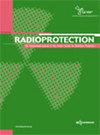高环境温度对环境监测用热释光剂量计精度的影响
IF 1.4
4区 医学
Q4 ENVIRONMENTAL SCIENCES
引用次数: 0
摘要
热释光剂量计(tld)广泛用于个人和环境剂量测定。tld在不同条件下应具有较高的精度。由于衰落(由于热诱导捕获的载流子重组而导致的信号损失),TL信号会随着时间的推移而下降,从而导致辐照剂量的低估。沙特的气候在一年中的大部分时间里都非常炎热,这可能会严重影响TLD的测量。因此,在实验室控制温度条件下和现场实验中,研究了环境温度、储存时间和辐照剂量的影响,使用了两种用于环境监测的商用剂量计:Harshaw (TLD-100H™)和RADCARD (MCP-N™)。辐照后的tld暴露于环境温度范围(25°C - 65°C),然后保存30、60和90天。由于环境温度和储存时间的增加,通常会观察到信号衰落。与TLD-100H相比,MCP-N表现出良好的稳定性,对环境温度升高的响应较小。与MCP-N相比,TLD-100H受储存时间的影响较小。辐射剂量在TL信号衰减中起作用,在所有类型的TLD中,5毫西弗辐射的TLD的损失率高于2毫西弗辐射的TLD。所得结果可以得出结论,本研究中使用的所有TLD类型都存在TL信号衰落,其程度因TLD类型而异。本文章由计算机程序翻译,如有差异,请以英文原文为准。
Effects of high ambient temperature on the accuracy of thermoluminescent dosimeters for environmental monitoring
Thermoluminescence dosimeters (TLDs) are widely used for both personal and environmental dosimetry. TLDs should have high accuracy under different conditions. The TL signal can drop over time because of fading (loss of signal due to thermally induced recombination of trapped charriers), thus leading to underestimation of the irradiation dose. The Saudi climate is extremely hot for most of the year, which could significantly affect TLD measurements. Therefore, the effect of ambient temperature, storage time and irradiation dose were investigated both in laboratory controlled-temperature conditions and field experiments, for two commercial dosimeters: Harshaw (TLD-100H™) and RADCARD (MCP-N™), which are used for environmental monitoring. The irradiated TLDs were exposed to a range of ambient temperatures (25 °C–65 °C) then stored for 30, 60, and 90 days. A signal fading due to increasing ambient temperature and storage time was generally observed. MCP-N shows good stability and is less responsive to increasing ambient temperature compared to TLD-100H. TLD-100H is less affected by storage time compared to MCP-N. Irradiation doses play a role in TL signal fading, and TLDs irradiated with 5 mSv have a higher rate of loss compared to those irradiated with 2 mSv in all TLD types. The obtained results permitted to conclude that all TLD types used in this study suffer from TL signal fading, and its degree varies between TLD types.
求助全文
通过发布文献求助,成功后即可免费获取论文全文。
去求助
来源期刊

Radioprotection
ENVIRONMENTAL SCIENCES-PUBLIC, ENVIRONMENTAL & OCCUPATIONAL HEALTH
CiteScore
3.30
自引率
54.50%
发文量
35
审稿时长
>12 weeks
期刊介绍:
Radioprotection publishes articles on all aspects of radiological protection, including non-ionising as well as ionising radiations. Fields of interest range from research, development and theory to operational matters, education and training. The very wide spectrum of its topics includes (theoretical and practical aspects): dosimetry, instrument development, specialized measuring techniques, epidemiology, biological effects (in vivo and in vitro) and risk and environmental impact assessments.
 求助内容:
求助内容: 应助结果提醒方式:
应助结果提醒方式:


